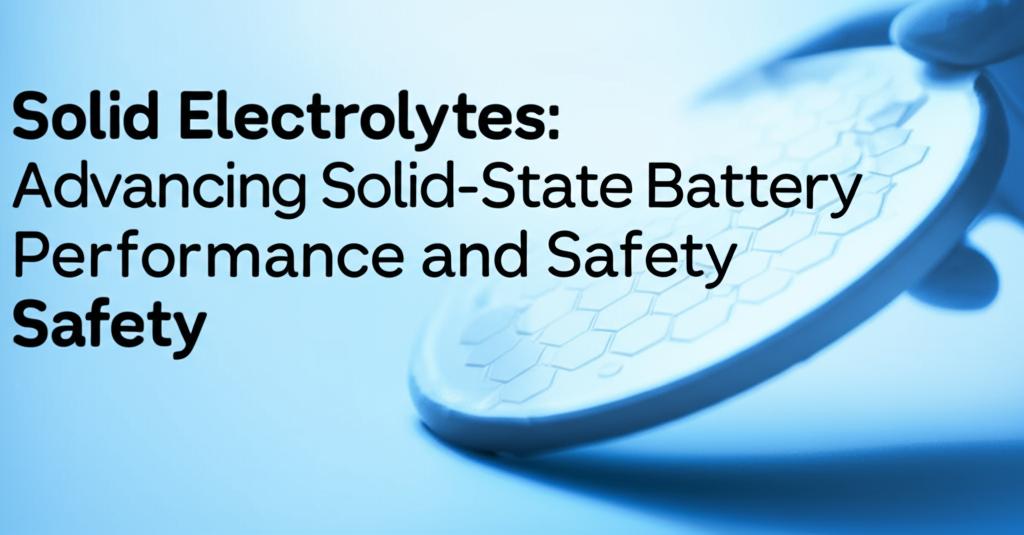Solid electrolytes represent a pivotal shift away from the liquid electrolytes used in conventional lithium-ion batteries. By utilizing a solid material to facilitate the movement of ions between the anode and cathode, solid-state batteries (SSBs) aim to overcome critical limitations, particularly concerning safety and energy density.
Enhancing Battery SafetyOne of the most significant advantages offered by solid electrolytes is enhanced safety. Traditional lithium-ion batteries contain flammable liquid electrolytes that can leak or catch fire under certain conditions, such as overheating or physical damage, potentially leading to thermal runaway. Solid electrolytes, being inherently non-flammable and resistant to leakage, drastically reduce these risks. Their solid nature also acts as a physical barrier, potentially suppressing the growth of lithium dendrites – needle-like structures that can form during charging in conventional batteries, causing short circuits and failures. This improved thermal and mechanical stability makes SSBs a much safer alternative. Furthermore, the thermodynamic stability of solid electrolytes is generally higher than liquids, slowing down potential reactions between electrodes and electrolyte, which can help prevent rapid temperature increases and provide more time for safety systems to respond if issues arise.
Boosting Performance MetricsBeyond safety, solid electrolytes unlock pathways to significantly improved battery performance.
- Higher Energy Density: Solid electrolytes are often compatible with high-energy anode materials, most notably lithium metal. Replacing the conventional graphite anode with lithium metal can dramatically increase the amount of energy stored in the same volume or weight. This translates to longer driving ranges for electric vehicles (EVs) or extended operating times for electronic devices without increasing battery size. Some research targets energy densities potentially double that of current lithium-ion batteries.
- Longer Lifespan: Solid electrolytes are generally more stable and less prone to degradation over repeated charge-discharge cycles compared to their liquid counterparts, which can break down over time, especially under thermal stress. This improved stability contributes to a longer operational lifespan for the battery.
- Wider Operating Temperatures: Many solid electrolytes maintain stable performance across a broader range of temperatures, including both high and low extremes, compared to liquid electrolytes which can suffer performance drops or stability issues in harsh conditions.
- Faster Charging: While challenges related to ion movement across solid interfaces exist, the potential for faster charging is a key goal. Some solid-state battery designs aim for significantly reduced charging times, with targets like charging from 15% to 90% in under 20 minutes being actively pursued and demonstrated in prototypes.
Research and development efforts are exploring several categories of solid electrolyte materials, each with distinct characteristics:
- Oxides (Ceramics): Materials like garnet-type (e.g., LLZO), NASICON, and perovskite structures offer good electrochemical and thermal stability, allowing compatibility with high-voltage cathodes and lithium metal anodes. However, they often exhibit lower ionic conductivity at room temperature compared to sulfides and can be brittle, leading to challenges in manufacturing and maintaining good contact with electrodes (high interfacial resistance).
- Sulfides: This class, including materials like LGPS and argyrodites, generally boasts high ionic conductivity, sometimes comparable to or even exceeding liquid electrolytes at room temperature. They also tend to be more ductile than oxides, facilitating better interfacial contact. Major drawbacks include sensitivity to moisture and air (requiring controlled manufacturing environments and potentially releasing toxic H2S gas) and potential instability against certain electrode materials.
- Polymers: Solid polymer electrolytes (SPEs) offer advantages like flexibility, light weight, and potentially lower manufacturing costs using processes similar to existing battery production. They generally provide good interfacial contact. However, they typically suffer from lower ionic conductivity at room temperature (often requiring elevated temperatures for optimal performance) and lower mechanical strength, making them less effective at preventing dendrite growth.
- Composites/Hybrids: A promising approach involves creating composite electrolytes that combine different materials (e.g., ceramic particles within a polymer matrix, or inorganic-organic hybrids). The goal is to leverage the strengths of each component – for instance, achieving the high conductivity and stability of ceramics with the flexibility and processability of polymers – while mitigating their individual weaknesses.
Significant progress is being made in addressing the hurdles associated with solid electrolytes:
- Improving Ionic Conductivity: Researchers are developing new material compositions (like pyrochlore-type oxyfluorides) and doping strategies to boost ion movement, especially in oxide and polymer systems at room temperature.
- Managing Interfaces: Optimizing the contact points between the solid electrolyte and the solid electrodes is crucial. Techniques like specialized coatings, interface engineering, and developing composite electrodes are being explored to reduce resistance and ensure stable ion transfer.
- Manufacturing and Scalability: High manufacturing costs and the complexity of producing large, defect-free solid electrolyte layers are major barriers. Innovations like advanced sintering techniques (e.g., ultrafast photonic sintering) and AI-driven material formulation are being investigated to improve efficiency and reduce costs. Companies are building pilot production lines to tackle these scaling challenges.
- Dendrite Suppression: While inherently better than liquids, preventing dendrite formation completely, especially with high-capacity lithium metal anodes, remains a focus. Material choice, interface design, and operating protocols are all factors being optimized.
- System-Level integration: Focus is shifting from individual cell chemistry to integrating these cells effectively into larger battery packs, considering factors like mechanical stress, thermal management (which differs from liquid systems), and overall pack architecture (e.g., bipolar stacking).
Solid electrolytes are at the forefront of next-generation battery research. While challenges in cost-effective mass production and ensuring long-term, real-world reliability persist, the potential benefits are transformative. Major automotive manufacturers and battery companies are investing heavily, with targets for initial commercial deployment, particularly in electric vehicles, set for the latter half of the 2020s. Continued innovation in solid electrolyte materials, interface engineering, and manufacturing processes promises to pave the way for safer, longer-lasting, and higher-energy batteries across numerous applications, from consumer electronics to grid storage and electric transportation.

